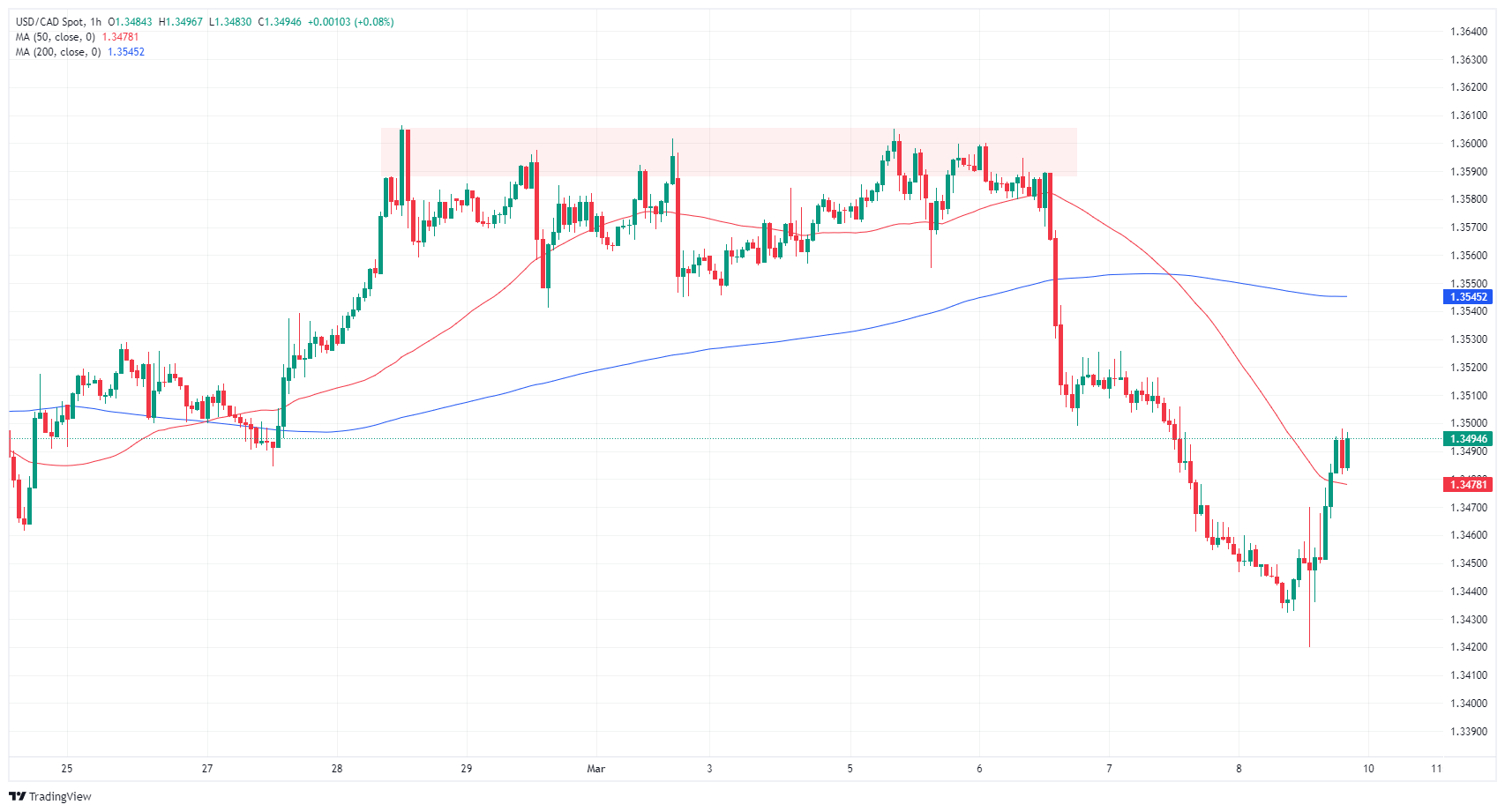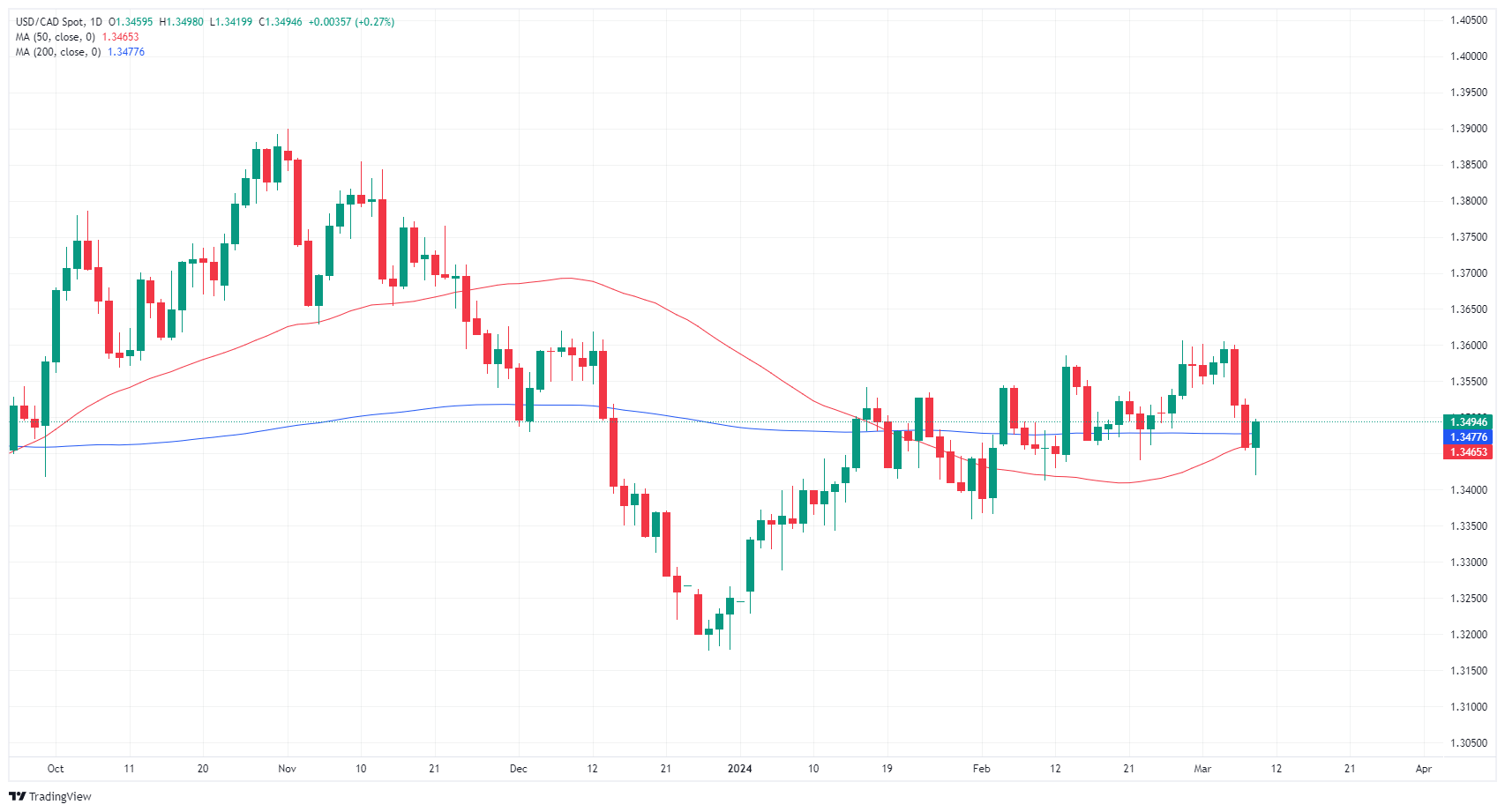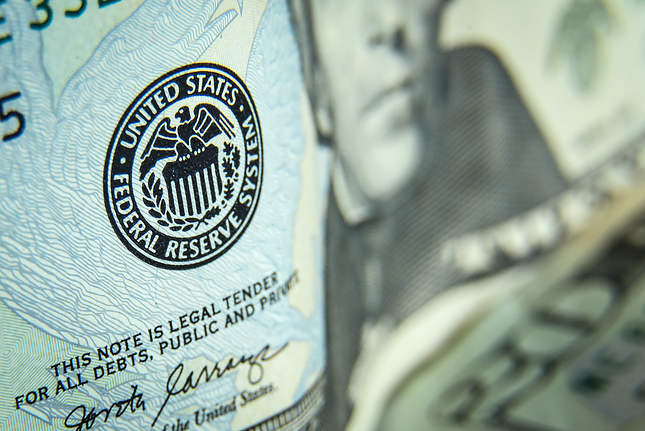Most recent article: Canadian Dollar flat against Greenback in thin Monday session, US CPI inflation in the barrel
- US NFP on Friday prints big upswing to expectations but steep revisions.
- Canada also mixed, adding more jobs than expected but softer wages.
- Next week: US CPI inflation, strictly low-tier Canadian data.
The Canadian Dollar (CAD) roiled against the US Dollar (USD) on Friday after US Nonfarm Payrolls (NFP) figures came in mixed, and Canadian employment figures were broadly overshadowed by US data. The CAD is broadly softer on the day, shedding weight against all of its major currency peers.
Canada added more jobs than expected in February, but wage growth slowed slightly while the Unemployment Rate ticked a bit higher. On the US side, a big beat on NFP forecasts was overshadowed by a massive downside revision to January’s jobs figure, leaving market sentiment hamstrung. Next week’s economic calendar is notably light on Canadian releases, and markets will be getting the next update on US inflation when February’s Consumer Price Index (CPI) prints next Tuesday.
Daily digest market movers: Split NFP print leaves markets churning on Friday
- The US NFP for February added 275K new jobs during the month versus the forecast of 200K.
- January’s NFP print saw a steep correction, revised down to 229K from the previous 11-month peak of 353K.
- Annualized Hourly Earnings growth for the year ended February eased to 4.3% versus the expected 4.4%, and the previous print saw a slight downside revision from 4.5%.
- The US Unemployment Rate also rose in February, ticking up to 3.9% compared to the expected steady print at 3.7%.
- Canada added 40.7K jobs in February, over double the forecast of 20K and rising slightly from the previous month’s 37.2K.
- The Canadian Unemployment Rate also ticked higher to 5.8% in February from 5.7%, in-line with expectations.
- Canadian Average Hourly Wages printed at 4.9% YoY, easing back from the previous period’s 5.3%.
Canadian Dollar price today
The table below shows the percentage change of Canadian Dollar (CAD) against listed major currencies today. Canadian Dollar was the strongest against the Euro.
| USD | EUR | GBP | CAD | AUD | JPY | NZD | CHF | |
| USD | 0.10% | -0.31% | 0.25% | -0.03% | -0.55% | 0.03% | 0.00% | |
| EUR | -0.10% | -0.42% | 0.15% | -0.14% | -0.65% | -0.08% | -0.12% | |
| GBP | 0.32% | 0.42% | 0.57% | 0.29% | -0.23% | 0.34% | 0.31% | |
| CAD | -0.25% | -0.15% | -0.57% | -0.29% | -0.81% | -0.23% | -0.26% | |
| AUD | 0.03% | 0.14% | -0.28% | 0.29% | -0.51% | 0.04% | 0.03% | |
| JPY | 0.54% | 0.64% | 0.23% | 0.80% | 0.51% | 0.58% | 0.53% | |
| NZD | -0.03% | 0.08% | -0.34% | 0.23% | -0.06% | -0.57% | -0.02% | |
| CHF | 0.02% | 0.11% | -0.31% | 0.26% | -0.03% | -0.54% | 0.03% |
The heat map shows percentage changes of major currencies against each other. The base currency is picked from the left column, while the quote currency is picked from the top row. For example, if you pick the Euro from the left column and move along the horizontal line to the Japanese Yen, the percentage change displayed in the box will represent EUR (base)/JPY (quote).
Technical analysis: Canadian Dollar softens on Friday, leaks recent gains against Greenback
The Canadian Dollar (CAD) is broadly softer on Friday heading into the trading week’s close, shedding around eight-tenths of a percent against the Japanese Yen (JPY) and falling about half a percent against the Pound Sterling (GBP). The CAD is also down about a third of a percent against the US Dollar and a fifth of a percent against the Euro (EUR).
The USD/CAD roiled during the US trading session, sending the pair down to 1.3420 before recovering into the 1.3475 region. The Loonie is still sharply down from the week’s highs near 1.3605, but it is recovering toward the midrange as Friday markets take aim at the weekend.
Friday’s post-dip recovery sends USD/CAD back into the 200-day Simple Moving Average (SMA) at 1.3477. The long-term moving average has flatlined just below the 1.3800 handle for most of 2024, and the pair is set to continue struggling in the near term as it churns within a rough range between 1.3600 and 1.3400.
USD/CAD hourly chart
USD/CAD daily chart
Canadian Dollar FAQs
What key factors drive the Canadian Dollar?
The key factors driving the Canadian Dollar (CAD) are the level of interest rates set by the Bank of Canada (BoC), the price of Oil, Canada’s largest export, the health of its economy, inflation and the Trade Balance, which is the difference between the value of Canada’s exports versus its imports. Other factors include market sentiment – whether investors are taking on more risky assets (risk-on) or seeking safe-havens (risk-off) – with risk-on being CAD-positive. As its largest trading partner, the health of the US economy is also a key factor influencing the Canadian Dollar.
How do the decisions of the Bank of Canada impact the Canadian Dollar?
The Bank of Canada (BoC) has a significant influence on the Canadian Dollar by setting the level of interest rates that banks can lend to one another. This influences the level of interest rates for everyone. The main goal of the BoC is to maintain inflation at 1-3% by adjusting interest rates up or down. Relatively higher interest rates tend to be positive for the CAD. The Bank of Canada can also use quantitative easing and tightening to influence credit conditions, with the former CAD-negative and the latter CAD-positive.
How does the price of Oil impact the Canadian Dollar?
The price of Oil is a key factor impacting the value of the Canadian Dollar. Petroleum is Canada’s biggest export, so Oil price tends to have an immediate impact on the CAD value. Generally, if Oil price rises CAD also goes up, as aggregate demand for the currency increases. The opposite is the case if the price of Oil falls. Higher Oil prices also tend to result in a greater likelihood of a positive Trade Balance, which is also supportive of the CAD.
How does inflation data impact the value of the Canadian Dollar?
While inflation had always traditionally been thought of as a negative factor for a currency since it lowers the value of money, the opposite has actually been the case in modern times with the relaxation of cross-border capital controls. Higher inflation tends to lead central banks to put up interest rates which attracts more capital inflows from global investors seeking a lucrative place to keep their money. This increases demand for the local currency, which in Canada’s case is the Canadian Dollar.
How does economic data influence the value of the Canadian Dollar?
Macroeconomic data releases gauge the health of the economy and can have an impact on the Canadian Dollar. Indicators such as GDP, Manufacturing and Services PMIs, employment, and consumer sentiment surveys can all influence the direction of the CAD. A strong economy is good for the Canadian Dollar. Not only does it attract more foreign investment but it may encourage the Bank of Canada to put up interest rates, leading to a stronger currency. If economic data is weak, however, the CAD is likely to fall.
Information on these pages contains forward-looking statements that involve risks and uncertainties. Markets and instruments profiled on this page are for informational purposes only and should not in any way come across as a recommendation to buy or sell in these assets. You should do your own thorough research before making any investment decisions. FXStreet does not in any way guarantee that this information is free from mistakes, errors, or material misstatements. It also does not guarantee that this information is of a timely nature. Investing in Open Markets involves a great deal of risk, including the loss of all or a portion of your investment, as well as emotional distress. All risks, losses and costs associated with investing, including total loss of principal, are your responsibility. The views and opinions expressed in this article are those of the authors and do not necessarily reflect the official policy or position of FXStreet nor its advertisers. The author will not be held responsible for information that is found at the end of links posted on this page.
If not otherwise explicitly mentioned in the body of the article, at the time of writing, the author has no position in any stock mentioned in this article and no business relationship with any company mentioned. The author has not received compensation for writing this article, other than from FXStreet.
FXStreet and the author do not provide personalized recommendations. The author makes no representations as to the accuracy, completeness, or suitability of this information. FXStreet and the author will not be liable for any errors, omissions or any losses, injuries or damages arising from this information and its display or use. Errors and omissions excepted.
The author and FXStreet are not registered investment advisors and nothing in this article is intended to be investment advice.
Recommended content
Editors’ Picks

AUD/USD holds steady near 0.6250 ahead of RBA Minutes
The AUD/USD pair trades on a flat note around 0.6250 during the early Asian session on Monday. Traders brace for the Reserve Bank of Australia Minutes released on Monday for some insight into the interest rate outlook.

USD/JPY consolidates around 156.50 area; bullish bias remains
USD/JPY holds steady around the mid-156.00s at the start of a new week and for now, seems to have stalled a modest pullback from the 158.00 neighborhood, or over a five-month top touched on Friday. Doubts over when the BoJ could hike rates again and a positive risk tone undermine the safe-haven JPY.

Gold: Is another record-setting year in the books in 2025?
Gold benefited from escalating geopolitical tensions and the global shift toward a looser monetary policy environment throughout 2024, setting a new all-time high at $2,790 and rising around 25% for the year.

Week ahead: No festive cheer for the markets after hawkish Fed
US and Japanese data in focus as markets wind down for Christmas. Gold and stocks bruised by Fed, but can the US dollar extend its gains? Risk of volatility amid thin trading and Treasury auctions.

Bank of England stays on hold, but a dovish front is building
Bank of England rates were maintained at 4.75% today, in line with expectations. However, the 6-3 vote split sent a moderately dovish signal to markets, prompting some dovish repricing and a weaker pound. We remain more dovish than market pricing for 2025.

Best Forex Brokers with Low Spreads
VERIFIED Low spreads are crucial for reducing trading costs. Explore top Forex brokers offering competitive spreads and high leverage. Compare options for EUR/USD, GBP/USD, USD/JPY, and Gold.